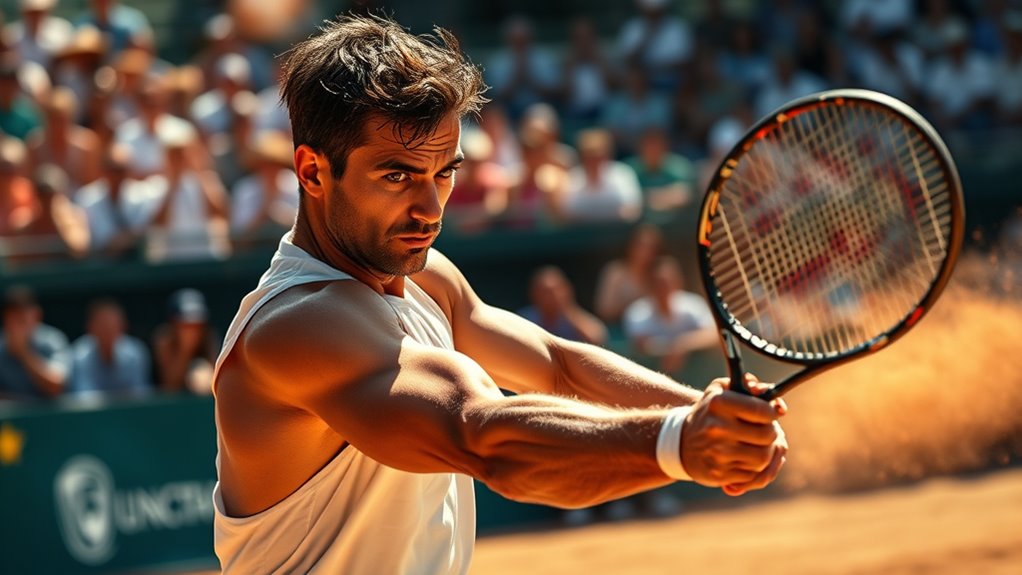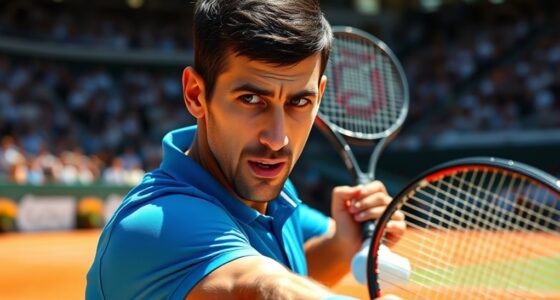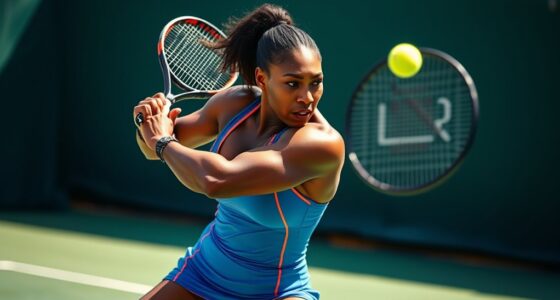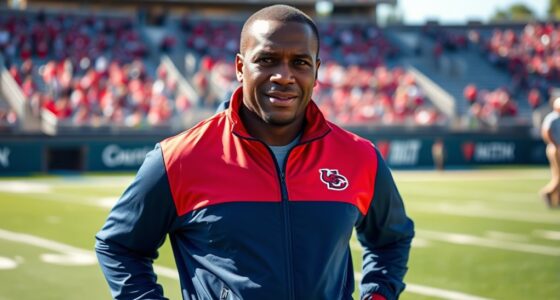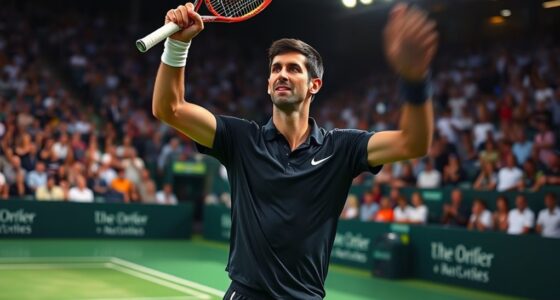Carlos Alcaraz is one of tennis’s brightest young stars, quickly rising to become the ATP’s No. 1 ranked player. At just 20, he has already won multiple Grand Slam titles, including the US Open, French Open, and Wimbledons, showing incredible versatility across all surfaces. His combination of agility, mental toughness, and strategic play makes him a dominant force. If you keep exploring, you’ll discover how he’s shaping the future of tennis.
Key Takeaways
- Became the youngest male world No. 1 in ATP history after winning the 2022 US Open at age 19.
- Achieved five Grand Slam titles across all surfaces, showcasing versatility and dominance early in his career.
- Surpassed legends with record-breaking wins, including Masters 1000 titles and significant victories over Nadal and Djokovic.
- Demonstrates exceptional adaptability across clay, grass, and hard courts with a complete, unpredictable playing style.
- Recognized for his rapid rise, strategic maturity, and growing global marketability as a leading young tennis phenom.
Rising Star: Early Career Highlights and Rapid Rise
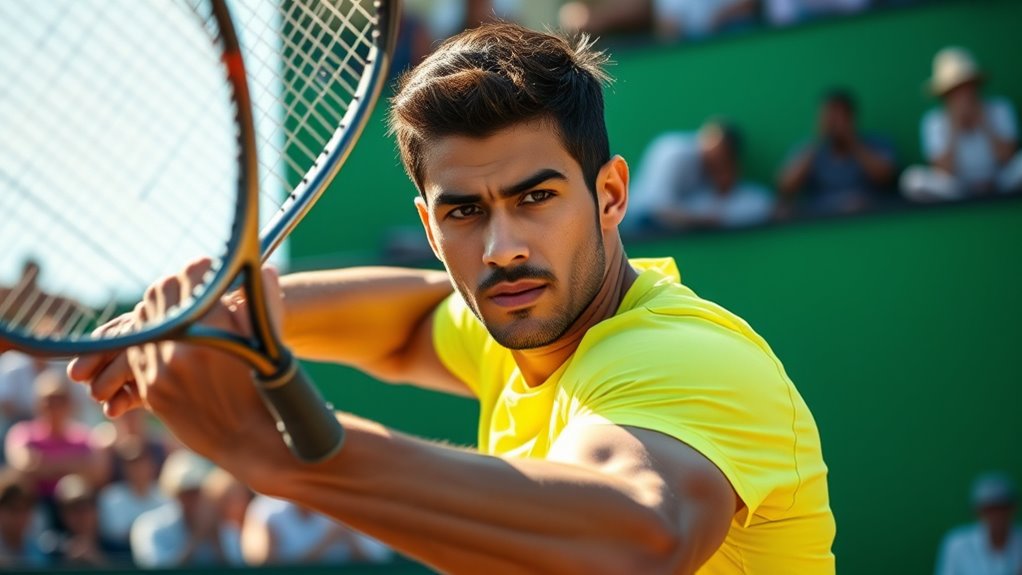
Carlos Alcaraz’s rise to prominence is proof of his exceptional talent and determination from a young age. You saw him start his professional journey at just 15, reaching the quarterfinals in his first ITF Futures event. By April 2019, he made his Challenger debut and beat Jannik Sinner, becoming the first player born in 2003 to win a Challenger match. At 16, he debuted on the ATP Tour at the Rio Open, winning his first match and becoming the youngest to do so. His breakthrough came in 2021, when he won his first ATP title at Croatia Open and reached the US Open quarterfinals. His rapid ascent reflects a relentless work ethic, strong mental toughness, and support from coaching legend Juan Carlos Ferrero.
Dominance on Grand Slam Stage: Titles and Record-Breaking Performances
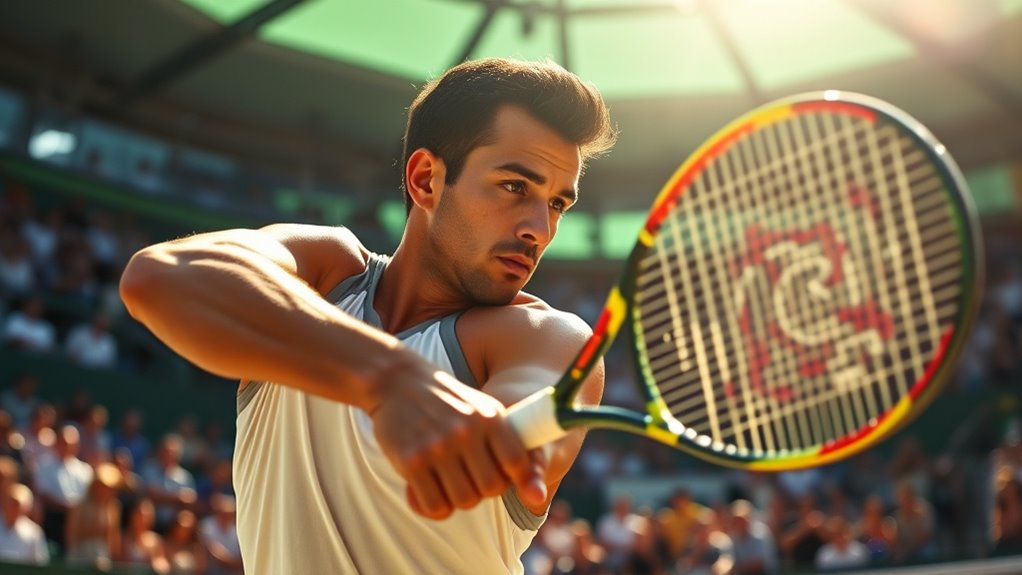
Alcaraz’s rise has been marked not only by rapid progress but also by his extraordinary success at the Grand Slam level. He’s claimed five titles, including two French Opens, two Wimbledons, and a US Open, with his first at the 2022 US Open making him the youngest male teenager in the Open Era to reach No. 1. His record in finals is impressive: 4-0, with resilience shown in comebacks like the 2025 French Open. He’s defeated top players such as Djokovic and Sinner, often turning setbacks into victories. His milestones include becoming the youngest year-end ATP No. 1 in 2022. The table summarizes his Grand Slam achievements:
| Title | Year | Final Opponent |
|---|---|---|
| US Open | 2022 | Ruud |
| Wimbledon | 2023 | Djokovic |
| French Open | 2024 | Sinner |
| Wimbledon | 2024 | Djokovic |
| French Open | 2025 | Sinner |
A key to his success has been his dedication to developmental milestones, which has helped him adapt and excel on various surfaces.
Mastering Multiple Surfaces: Versatility and Adaptability
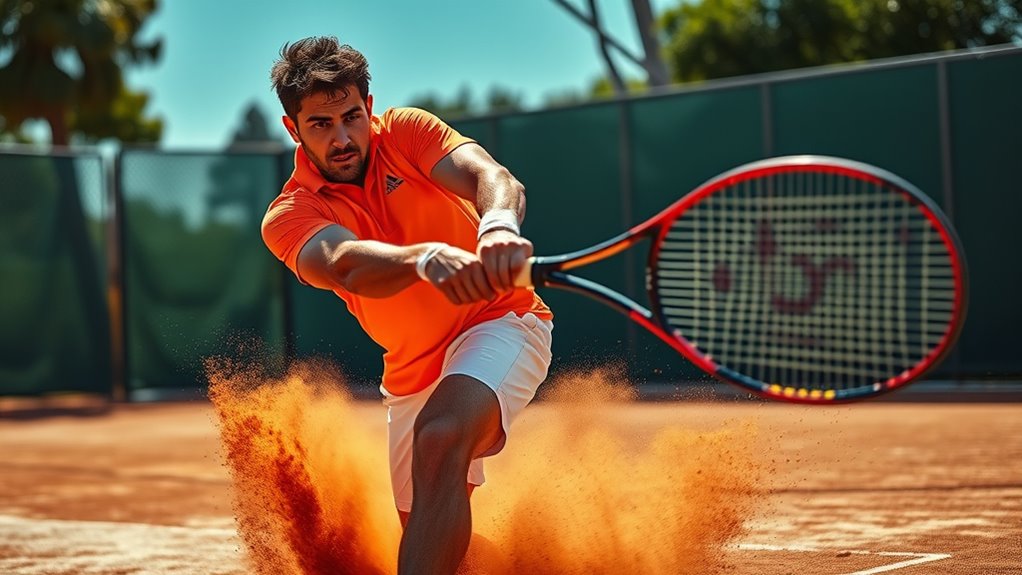
You can see how Alcaraz shifts smoothly between surfaces, showcasing his technical adaptability. His ability to perform consistently across clay, grass, and hard courts highlights his versatile skill set. This adaptability makes him a formidable opponent no matter the playing conditions. Additionally, his mental resilience is supported by his capacity to stay focused and composed, which is essential for handling diverse playing environments.
Surface Transition Skills
Mastering multiple surfaces requires you to adapt quickly and refine your technical and tactical skills to suit each court’s unique demands. On faster surfaces like grass, you use shorter, more compact swings to generate quick racquet head speed and control, while adjusting your sliding technique based on surface speed—extensive sliding on clay helps maintain balance and power. You’ll rely more on slices and drop shots on grass to exploit the lower bounce and speed. Footwork patterns shift too, becoming quicker and more agile on grass and hard courts, compared to longer, sustained movements on clay. Incorporating net approaches and volleys becomes essential on faster courts to finish points early. Additionally, practicing your surface-specific skills ensures you can adapt seamlessly to any playing condition. This versatility enables you to perform confidently across surfaces, seamlessly changing and maintaining high-level play in different conditions.
Consistent Performance Across Courts
Carlos Alcaraz consistently demonstrates high-level performance across all court surfaces, reflecting his remarkable versatility and adaptability. His career win percentages—88.1% on grass, 81.1% on clay, and 74.9% on hard courts—show he’s competitive everywhere. In 2025, he maintains an 82.8% win rate, confirming his ongoing consistency. His Grand Slam finals appearances and victories on each surface highlight his ability to excel at the highest level. His serve improvements boost success on grass and hard courts, with an average of 6.36 aces per match. His aggressive net play and tactical versatility, inspired by legends, enhance his game across surfaces. Endurance and mental toughness guarantee deep runs on clay, grass, and hard courts, cementing his status as a multi-surface master. Additionally, his ability to adapt his game strategy to different conditions is a key factor in his success across all surfaces.
Key Victories in 2025: A Year of Major Wins
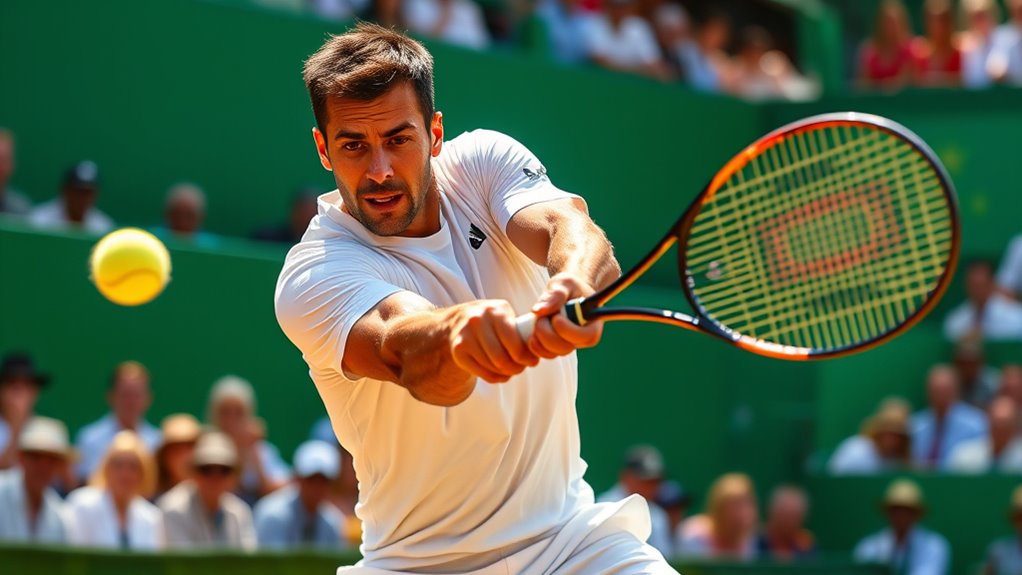
2025 has proven to be a landmark year for Carlos Alcaraz, marked by a series of major victories that solidify his status as a tennis superstar. He secured his second consecutive French Open title, joining Rafael Nadal and Novak Djokovic as one of only three men to win all major modern clay titles. His win at the Monte-Carlo Masters and Italian Open added to his collection of Masters 1000 titles, showcasing his dominance on clay. On grass, he reached his third Wimbledon final, surpassing Nadal’s Grand Slam match wins at this stage. Early in the year, he won his first indoor hardcourt title at Rotterdam and made a deep run at the Australian Open. These victories, combined with his consistent performance across surfaces, highlight 2025 as a standout year in his rising career. In addition, his cumulative match wins now surpass those of many tennis legends at this stage of their careers, indicating his rapid ascent in the sport. Additionally, his training regimen has become increasingly rigorous, contributing to his sustained success and resilience.

The intense competition on the ATP circuit in 2025 highlights the fierce rivalries shaping the sport’s landscape. You face top contenders like Jannik Sinner, who’s challenged Alcaraz in major finals and remains at No. 1, and Novak Djokovic, who’s defeated Alcaraz in key tournaments like the Australian Open and Olympics. Jack Draper, strong on grass and hard courts, is a rising threat, while Holger Rune’s consistent top-10 presence and recent finals show his competitiveness. Rising stars like Lorenzo Musetti, Alex de Minaur, and Jiří Lehečka add fresh energy, often pushing Alcaraz in late rounds. On specific surfaces, rivalries develop with clay specialists like Sinner, Djokovic, and Musetti, and hardcourt rivals such as Draper and Shelton. Mastering this landscape demands focus amid relentless competition. Additionally, understanding surface-specific strategies is crucial for maintaining an edge against these talented opponents.
Playing Style and Strengths: The Making of a Complete Player
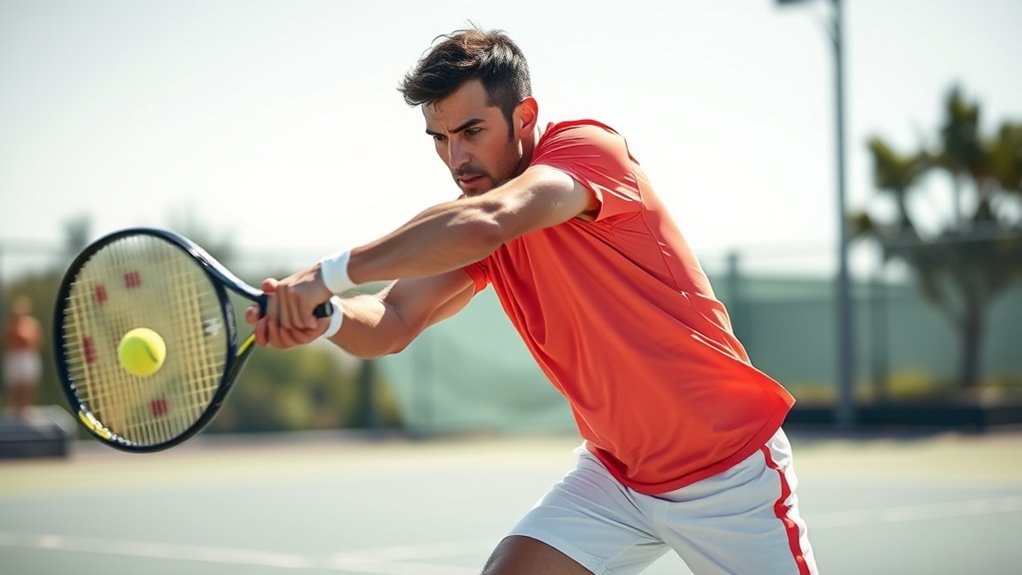
A key reason Carlos Alcaraz stands out on the court is his versatility, which stems from a well-rounded playing style that combines aggressive baseline tactics with exceptional movement. His forehand is a powerful weapon, loaded with heavy topspin and capable of dictating rallies, often employing drop shots to disrupt opponents’ rhythm. His outstanding court coverage comes from quick, agile footwork, allowing him to chase down shots and turn defense into offense effortlessly. Alcaraz adapts seamlessly across surfaces, leveraging faster serves on grass and adjusting his game on clay to minimize errors. His mental toughness keeps focus during tense moments, while his physical strength ensures explosive movement and sustained energy. This combination of power, agility, and resilience makes him a complete, unpredictable player. His agility also enables him to reach difficult shots effectively, creating offensive opportunities through quick court coverage. Additionally, understanding the contrast ratio of his equipment helps him adapt to different lighting conditions on the court, optimizing his performance.
Milestones and Historic Achievements
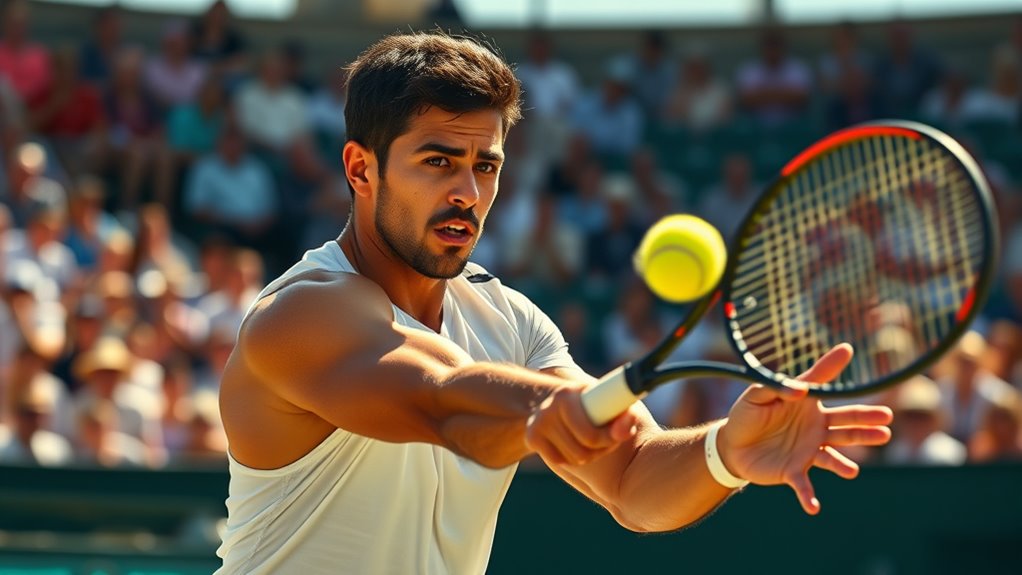
Carlos Alcaraz has rapidly etched his name into tennis history through a series of groundbreaking milestones and achievements. Turning professional in 2018, you reached the ATP top-25 quickly and made your Grand Slam debut at the 2020 French Open. In 2022, you became the youngest player to win the Madrid Open and defeated both Nadal and Djokovic on clay, setting a historic record. You also became the youngest to win the Miami Open Masters 1000, earning Spain’s first in that category. Your first Grand Slam title came at the 2022 US Open at just 19, making you the youngest men’s champion since Pete Sampras. Additionally, your victories at Wimbledon in 2023 and 2024, along with the French Open in 2024, highlight your rapid rise and record-breaking achievements across surfaces. He also achieved a career-high ATP ranking of #1, showcasing his dominance in the sport.
The Impact of Youth and Maturity on His Game
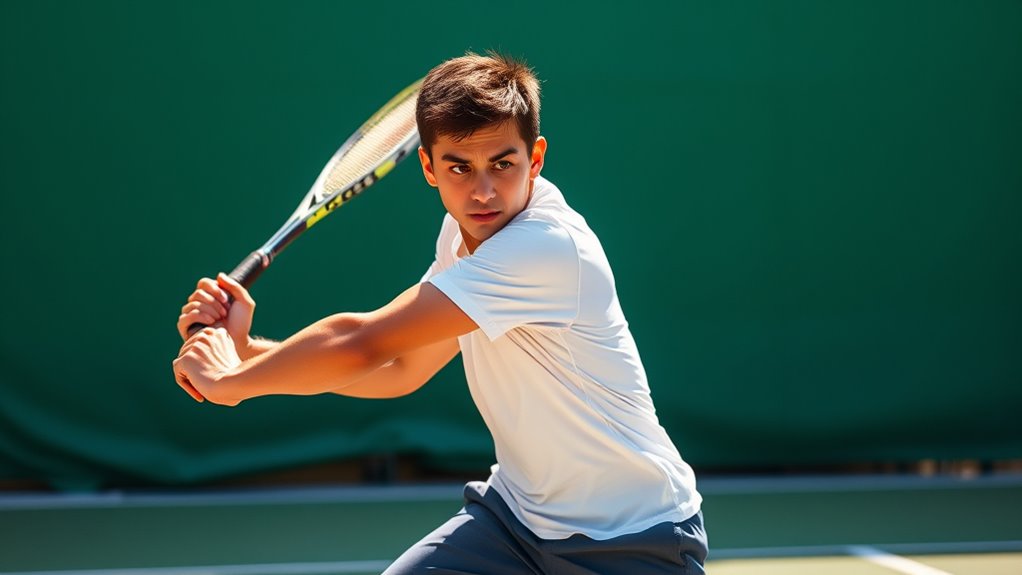
As he gains more experience on the court, the blend of youth and maturity considerably shapes Alcaraz’s game, making him more composed and strategic under pressure. He reports feeling “more mature” and “a better player” than last year, which shows in his improved mental resilience. Despite an impressive 56-3 record and six titles, he’s still vulnerable to return errors, especially on forehands. His ability to reset during tough matches, like overcoming a 6-1 first set loss at Wimbledon, highlights growing emotional control. His adaptation across surfaces, including grass, reflects strategic maturity, studying champions like Federer and Murray. Enhanced physical endurance and mental conditioning, alongside technical improvements, enable him to handle intense matches and stay focused, demonstrating the powerful impact of his youthful energy combined with developing maturity. Additionally, honing mental resilience can further elevate his performance in high-pressure moments.
Future Prospects: What Lies Ahead for the Young Phenom
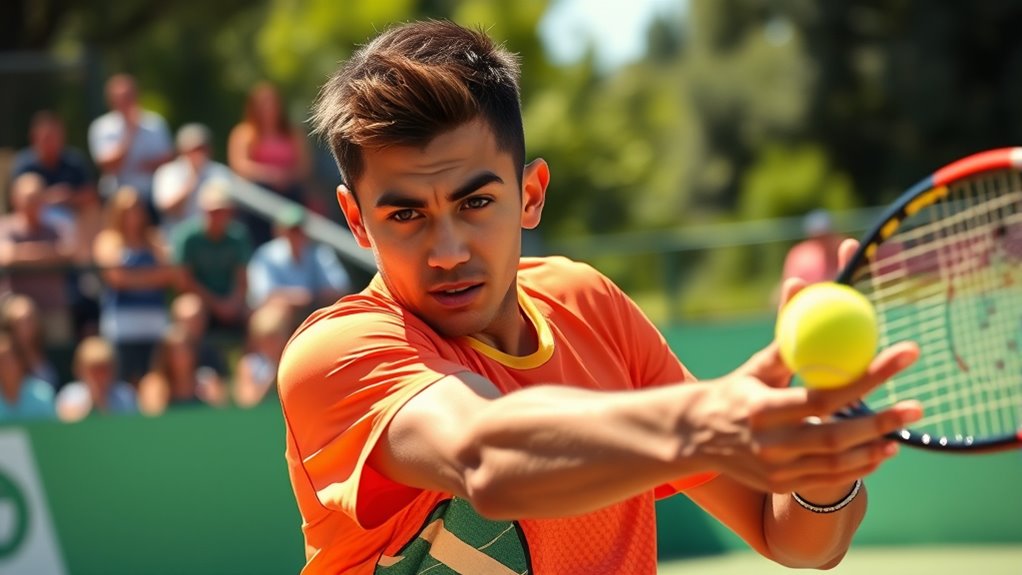
With his growing experience and technical improvements, the future looks exceptionally promising for this young tennis phenom. You can expect him to pursue a Career Grand Slam, having already won major titles like the US Open and Wimbledon, with more on the horizon before age 22. He aims to extend his Grand Slam tally beyond five and claim additional Masters 1000 titles, potentially becoming the youngest player to win on all surfaces after Rotterdam 2025. Financially, his net worth could reach $40–42 million by mid-2025, driven by prize money and endorsements from brands like Nike and Rolex. Despite fierce competition and occasional setbacks, his resilience, technical development, and strategic focus position him to challenge historical records and cement his legacy in tennis’s future landscape. His marketability continues to grow, further increasing his appeal to sponsors and fans worldwide. Additionally, his growth in popularity aligns with the increasing global interest in tennis, which is fueling sponsorship opportunities and media coverage.
Frequently Asked Questions
How Does Alcaraz’s Playing Style Compare to Past Tennis Legends?
You’re curious about how Alcaraz’s playing style stacks up against tennis legends. He combines explosive power and aggressive shotmaking, especially with his blistering forehand, unlike Nadal’s endurance-based game or Federer’s finesse. His athleticism and court coverage are exceptional, allowing creative shot choices. While he plays high-risk, he’s mentally tough and versatile, giving him a unique blend of power, agility, and adaptability that mirrors some of the best, yet still evolving.
What Are Alcaraz’s Main Weaknesses or Areas for Improvement?
You might notice that despite Alcaraz’s rapid rise, his serve still has room for growth. While he’s transformed it into a weapon, opponents still exploit its predictability, especially on pivotal points. Improving serve variety—like mixing slice, kick, and flat serves—can make him less predictable. Additionally, maintaining consistent mental focus under pressure and adapting tactics quickly during matches will help him fully realize his potential.
How Has Alcaraz’S Mental Resilience Contributed to His Success?
Your mental resilience plays a vital role in your success by helping you stay focused under pressure and bounce back from setbacks quickly. It allows you to perform consistently in clutch moments, like tie-breaks and deciding sets, giving you an edge over opponents. By managing stress and maintaining emotional control, you build confidence and trust in your abilities, ultimately elevating your game and leading to more wins at critical points.
What Are His Long-Term Career Goals Beyond 2025?
Your long-term goals extend beyond 2025, aiming to cement your legacy as one of tennis’s greats. You want to win multiple Grand Slam titles, break records for youngest champions, and reach the top of the ATP rankings consistently. You’re committed to maintaining peak physical health, refining your game against top rivals, and evolving your strategy. Ultimately, you seek to inspire future generations and leave a lasting mark on the sport.
How Does His Popularity Influence His Performance and Marketability?
Imagine a spotlight so bright it feels like the Renaissance, illuminating your every move. Your popularity boosts your confidence, pushing you to perform under pressure, like saving championship points. It attracts sponsors, making you a marketable icon. Your active social media engages fans worldwide, growing your brand. Every victory and memorable match creates a ripple effect, increasing your visibility, endorsement deals, and influence, which fuels your journey to even greater heights.
Conclusion
As you watch Carlos Alcaraz’s rise, imagine a young sapling growing into a towering tree—full of potential yet rooted in resilience. His youthful energy fuels bold victories, while his maturity offers steady, measured growth. Together, they create a striking contrast: the raw power of a rising star against the calm confidence of a seasoned champion. This juxtaposition promises a future where he’s not just a fleeting phenomenon but a lasting legend.

